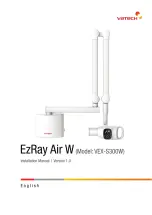
2.1.8 Examples of control using the terminal program
This describes examples of control using a general terminal program.
Referring to the example below, make the port setting for the terminal program.
Baud rate
Communication speed set on the AR-3000SD
Data bit length
8
Parity None
Stop bits
1
Flow control
Xon/Xoff
Making the setting to perform local echo makes it possible to use the terminal program to view
commands sent to the AR-3000SD.
Prepare a card on which some phrase is recorded as the first phrase.
When cable connections and settings are correct, then inserting a card into the AR-3000SD, the terminal
program displays "stxCC:1,0;" as shown below. “stx” is an ASCII-code signal name. It is a control code
indicating the start of a transmission, and is 02h in hexadecimal. The method used to display control
codes varies according to the terminal program. Depending on the terminal program, it might not be
displayed.
stxCC:1,0;
If this is not displayed, check the cable connections and the selected port. If text corruption occurs, it is
possible that the baud rate setting is incorrect.
When a PL command (stxPL;) is sent from the computer to the AR-3000SD, the first phrase is played
back. The method used to send the stx command varies according to the terminal program. In a typical
terminal program, stx can be sent by holding down "Ctrl" on the keyboard and pressing the "B" key. Type
in "Ctrl + B", "P", "L", ";". Type "P" and "L" as upper-case letters.
stxPL;
When a PL command is received, the AR-3000SD returns “ack” to the computer. “ack” is an ASCII-code
signal name. It is a control code indicating correct reception, and is 06h in hexadecimal.
ack
When phrase playback ends, the AR-3000SD returns an ST command (stxST:0;) to the computer.
stxST:0;
AR-3000SD (Ver.1.00) Command Reference - 8









































